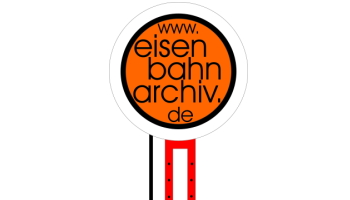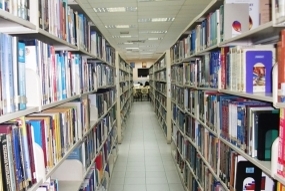Winterausklang im Allgäu vor 20 Jahren
Nachdem der Winter mitten im April noch einmal in einige Gegenden Deutschlands zurückgekehrt ist, wird es Zeit, dass er geht. Gelegenheit, sich auch bildlich von ihm zu verabschieden. Im April 2004 - allerdings bereits am 2ten - schien im Allgäu die Sonne und nur noch ein paar Schneereste zeugten vom weichenden Winter.
Bei km 33,8 der Ausserfernbahn unterhalb der Burgruine Falkenstein begegnet uns 642 092-1 und 642 592-0 auf dem Weg nach Kempten.
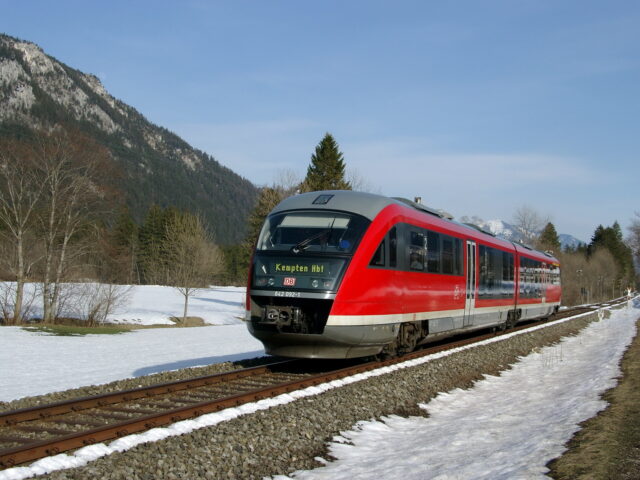
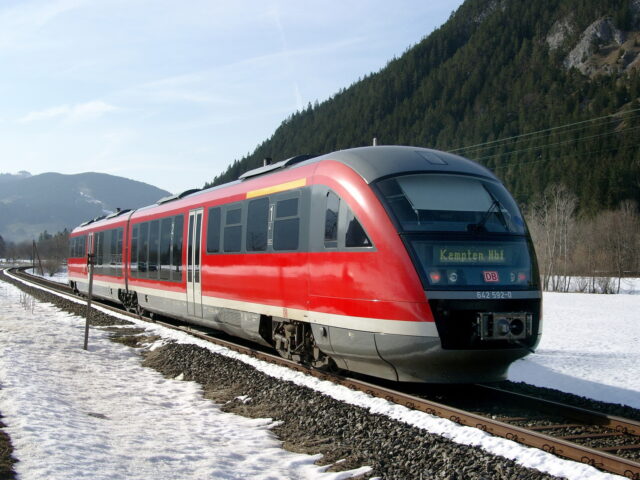
In Nesselwang war noch der Vorserien 628 009-3 und 628 019-2 unterwegs. Im Januar 2006 wurde er nach Polen verkauft.
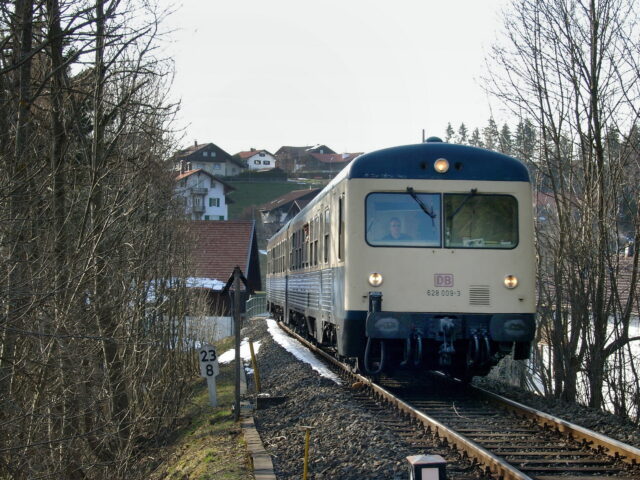
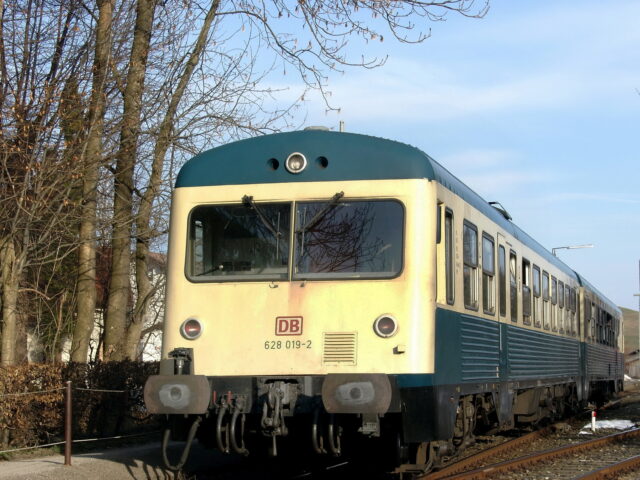
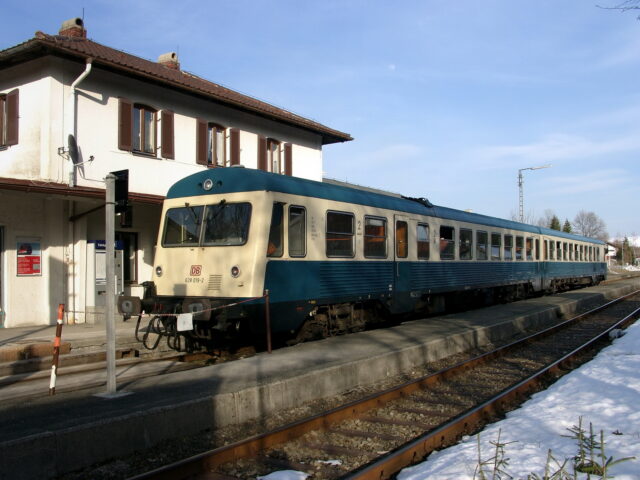

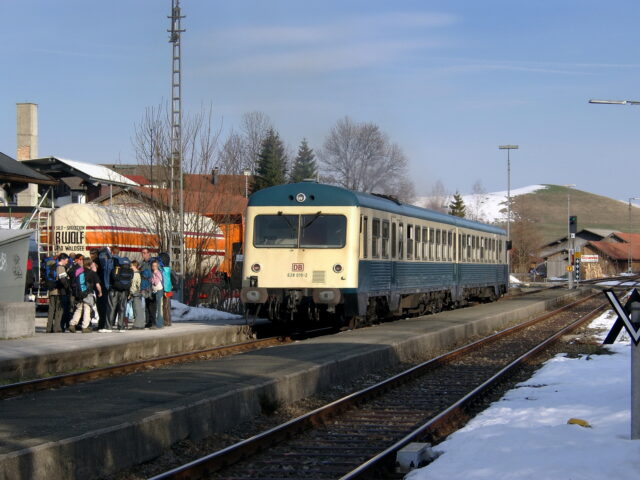
Im Kempten gab es natürlich die 218er zu sehen. Hier die 218 202-0 und die 218 239-2. Beide Maschinen tun bis heute ihren Dienst.
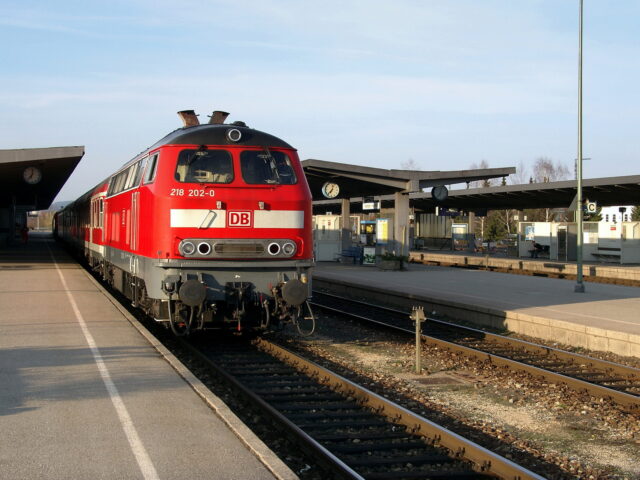
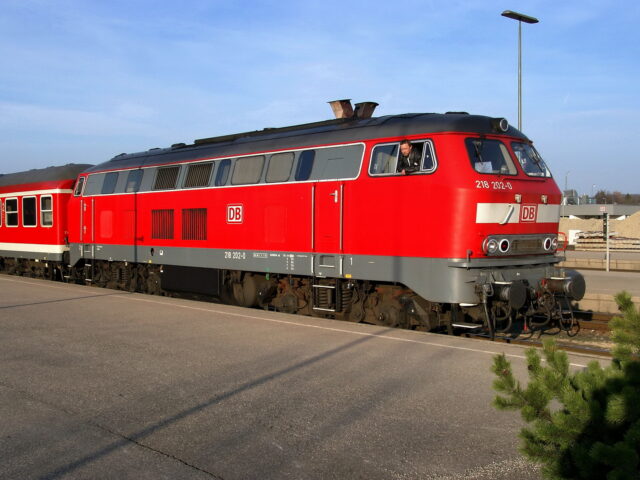
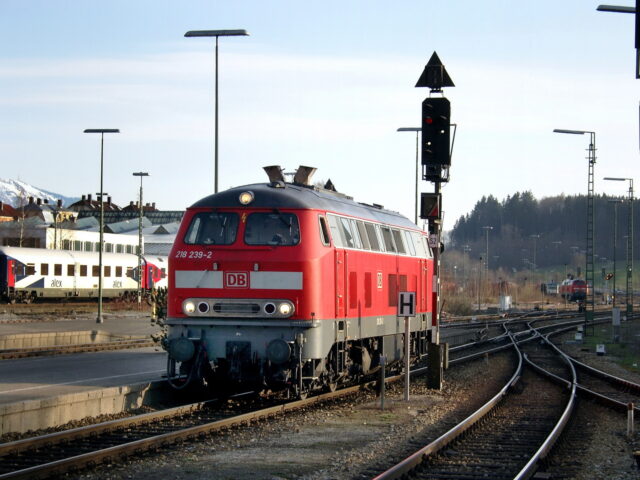
Auch ein Dreibein durfte nicht fehlen - die 364 912-6. Ihre Ausmusterung erfolgte im Juli 2008.
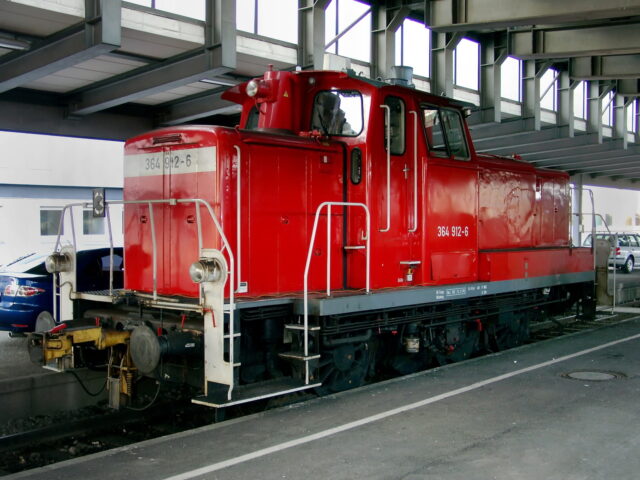
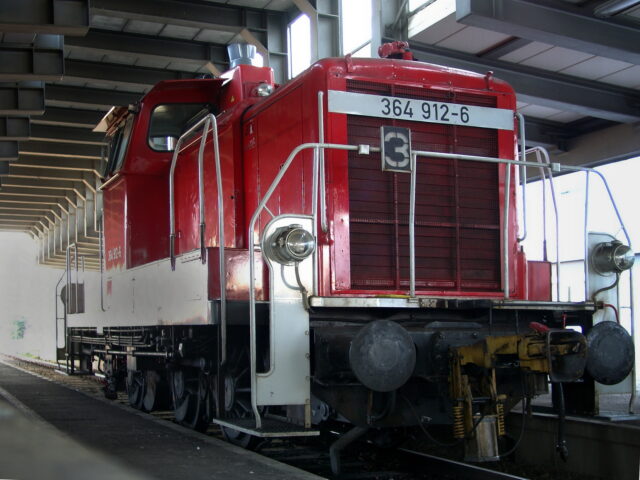
Im Bw Kempten warten 842 089-7, 842 078-0 sowie 612 084-4 auf den nächsten Einsatz. Und am Bahnsteig 612 583-5 auf den Weg nach Lindau.
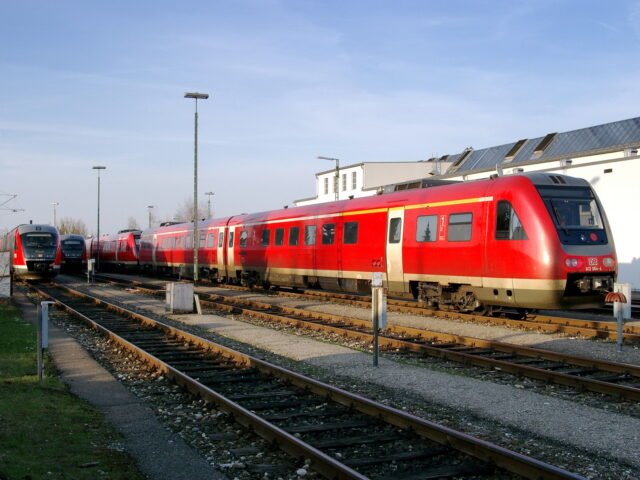
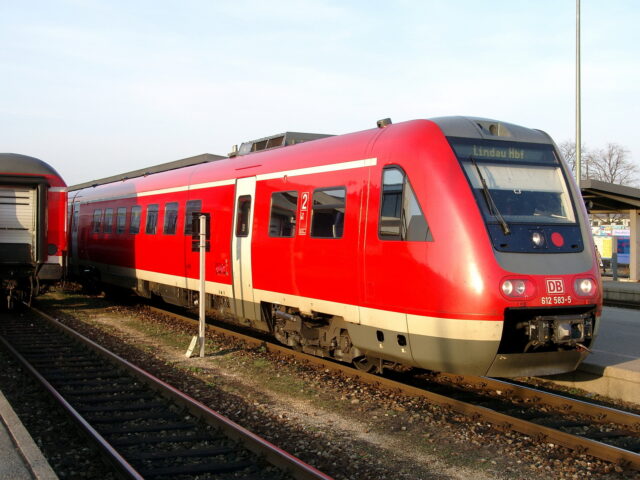
Auch Alex ist unterwegs - mit der gelb-silbernen Dispolok ER 20-001 und den Alex Bomz mit der seinerzeitigen Lackierung.
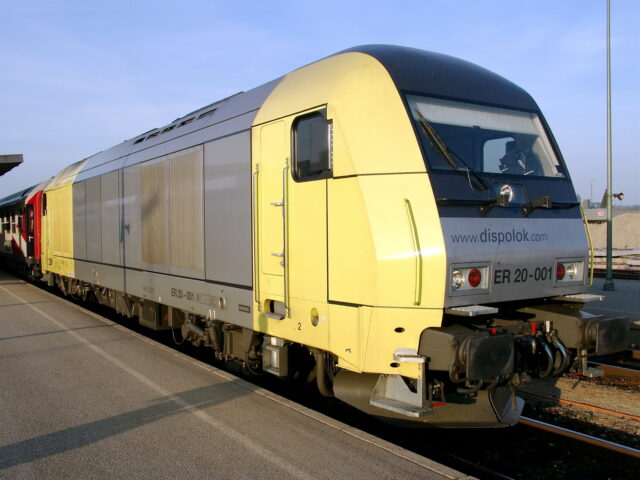
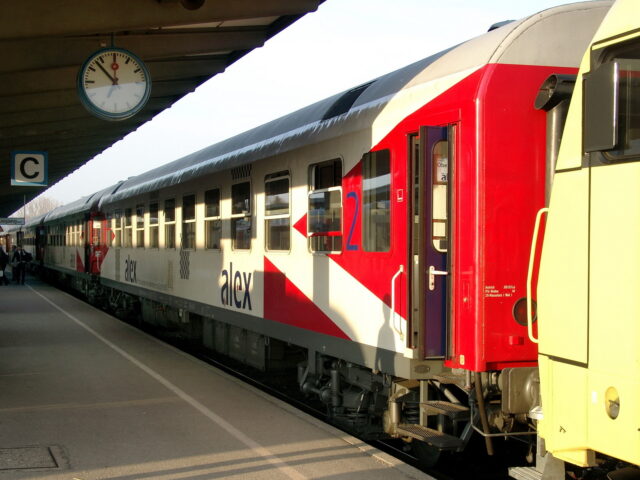
Hans Kobschätzky
Einst und Jetzt – Ein Blick von der Berliner Moltkebrücke mit 50 Jahren Abstand
Es muss August 1957 gewesen sein, als diese Aufnahme von der Berliner Moltkebrücke entstand. Die erste Teilsprengung der linken Arkaden am 09.Juli 1957 ist erfolgt, doch das am 22. April 1958 gesprengte Hauptportal steht noch. Der Ford Taunus P1 aus Pinneberg trägt zeitlich passend auch bereits weiße Kennzeichen, die ab dem 1.Juli 1956 eingeführt wurden. Rechts hinter der Ruine schaut der Hamburger Bahnhof hervor.

Fünfzig Jahre später, ebenfalls im August - am 09.August 2007 - entstand die Vergleichsaufnahme, die den neuen Berliner Hauptbahnhof von der Moltkebrücke aus zeigt.
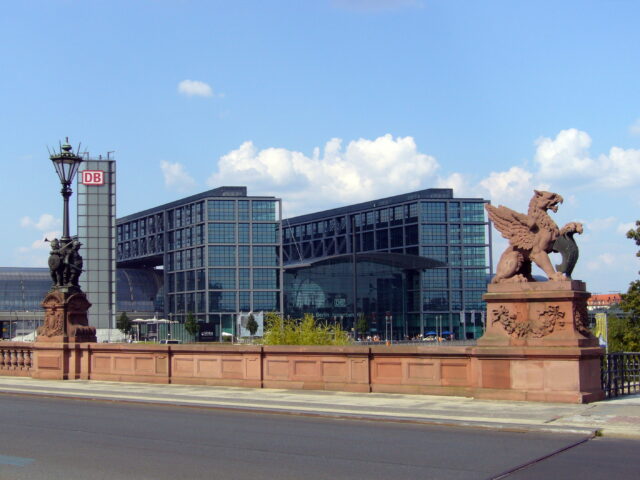
Das besondere Bild – Mit der württembergischen ADh im Donautal
Wer kennt es nicht, das schöne Donautal. Alte Eisenbahnaufnahmen von dort sind freilich selten. Und dann noch mit einer alten württembergischen Länderbahnmaschine.
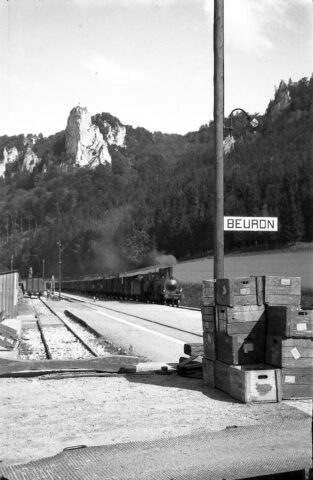
Den Aufnahmeort verrät das Bild von selber. Es entstand in Beuron - etwa 100km südwestlich von Ulm. Doch vor 100 Jahren war das in den Köpfen der Menschen sicher noch eine große Entfernung - heute ein schöner Tagesausflug. Hoch ragt der Petersfelsen mit seinem Kreuz über der Bahnstrecke auf. Am Bahnsteig stehen zahlreiche Kisten mit Flaschen und ganz vorne eine Ladebrücke, mit welcher der Zugang zu den zu beladenden Wagen erleichtert wurde.
Ein langer Personenzug mit einer ADh, zwei Güterwagen, Packwagen und württembergischen Personenwagen rollt herein.
Leider ist das Negativ nicht datiert. Es könnte über 100 Jahre alt sein, aber auch ein paar Jahre jünger. Die Loknummer an der Rauchkammertür ist zumindest noch württembergisch. Deren Entzifferung ist freilich nicht möglich - die Nummer verschwindet in der Körnung des Negativs. Ausgemustert wurden die letzten ADh Heißdampfmaschinen erst 1932.
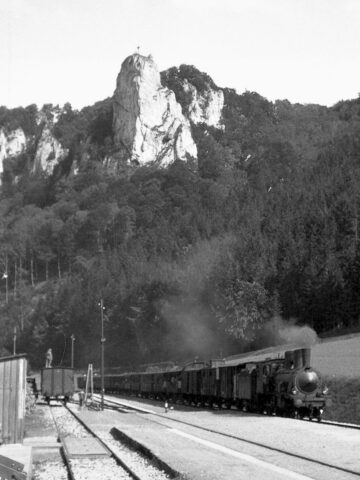
Das besondere Bild – 1961 – Das letzte Jahr mit dem Ext 166 durch Spandau nach Hamburg
Erschwernisse beim Wechsel von einer zur anderen Besatzungszone waren die Deutschen seit Kriegsende gewohnt. Erst mit dem Zusammenwachsen der Westzonen und kurz nach der Gründung der Bundesrepublik entfielen ab dem 01.November 1949 dort die Verkehrskontrollen. Für den Verkehr mit der DDR blieb der Zwang des Interzonenpasses jedoch noch weitere 4 Jahre bis Ende 1953 bestehen. Allerdings mussten Reisende aus der DDR in den Westen jetzt eine "Personalbescheinigung" - also eine Reisegenehmigung - beantragen und für die Dauer der Reise den Personalausweis bei den Behörden abgeben.
Das Grenzregime an der Demarkationslinie zwischen der BRD und DDR war bereits 1952 so verschärft worden, dass es dem entsprach, was ab dem 13.August 1961 durch den Mauerbau auch für Berlin gelten sollte. Denn durch das "Schlupfloch" in Berlin verließ ein nicht endender Strom qualifizierter Fachkräfte die DDR in Richtung Bundesrepublik. Über 2,9 Millionen Menschen seit Gründung der DDR bis Ende 1960. Und jeden Tag kamen neue hinzu. Ergebnis war am Ende der Beschluss der Regierung der DDR die Grenze auch in Berlin zu schließen.
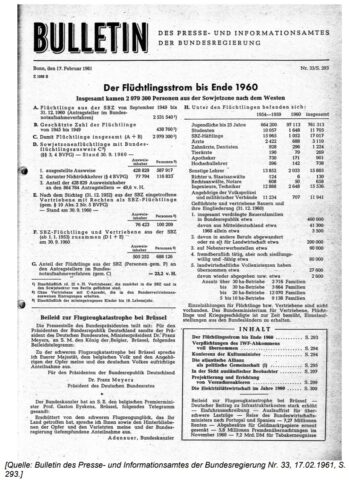
In der Nacht vom 12. auf den 13. August 1961 gab Walter Ulbricht schließlich den Befehl zur Abriegelung der Sektorengrenze in Berlin. Strasßnpflaster wurde aufgerissen, Stacheldraht verlegt und schließlich Häuser zugemauert und aus Hohlblocksteinen eine Mauer errichtet.
Auch für den S-Bahn Verkehr hatte dies gravierende Folgen. S-Bahn Stationen wurden verschlossen, Züge durcheilten sie ohne Halt. Ein Wechsel der östlichen und westlichen Sektoren wurde unmöglich.
Der 13.August 1961 wurde damit zu einem schicksalhaften Tag. Manchen gelang noch der Weg in den Westen, bei anderen wurden durch die Ereignisse des Tages Familien zerrissen. Andere wollten auch zurück in die DDR.
Der letzte Zug, der Berlin vor der Grenzschließung verließ, war der D110 Berlin-Köln. Der Laufweg begann am Ostbahnhof, führte über Berlin-Friedrichsstraße, Berlin-Zoo und Magdeburg zur Grenze nach Marienborn, dann weiter nach Helmstedt und schließlich Köln.
Am Bahnhof Berlin Friedrichstraße spielte sich dabei eine dramatische Szene ab, als eine junge Frau dem bereits anfahrenden Zug hinterherrennt, gerade noch aufspringen kann und von ihrer Mutter in den fahrenden Zug hineingezogen wird. Geschildert hat sie diese Erlebnisse einer Berliner Zeitung, bei der die Geschichte hier abgerufen werden kann:
An sich sollte der Zug Friedrichstraße bereits um 9:28 Uhr verlassen, doch durch die Ereignisse der Abriegelung Ost-Berlins und die Präsenz von Verkehrsminister Kramer am Bahnhof ist es eher nach 11:00 Uhr bis der von einer 01 geführte Zug aus der Halle rollt.
Im Fernverkehr änderte sich durch den Mauerbau wenig - Züge verkehrten weiter zwischen Ost und West. Dies war schon allein wegen der wirtschaftlichen Abhängigkeit der DDR und der mit einem Entfall der Reisezüge einhergehenden diplomatischen Verstrickungen nicht möglich. Doch viele Züge verkehrten nur noch als Transitzüge mit verschlossenen Türen von und nach Berlin. Und die wenigen, auch an Stationen der DDR haltenden Züge wurde strengstens kontrolliert. Ein Verlassen der DDR war für deren Bürger unmöglich geworden.
Anfangs wurden auch noch alle Verbindungen über dieselben Strecken geführt. Doch dies sollte sich ändern. So war geplant, den Zugverkehr Berlin-Spandau-Albrechtshof-Falkensee in Richtung Hamburg ab dem 10.12.1961 über den Bahnhof Griebnitzsee umzuleiten. Gab es doch für aus Falkensee den Bahnhof Ablbrechtshof in Richtung Spandau - also Westberlin - fahrende Züge keine geeigneten Grenzsicherungen. Diese Situation nutzte am 06.12.1961 der Lokführer Harry Deterling, als er mit seinem Personenzug 2192 aus Oranienburg kommend abends um 20:45 den Bahnhof Albrechtshof mit hoher Geschwindigkeit durchfuhr und die Grenze durchbrach. Dabei der Heizer, seine Familie und weitere Personen. 30 Reisende verließen den Zug nach dem Grenzdurchbruch und waren damit in Westberlin, 19 kehrten zu Fuß in die DDR zurück.
Eine genaue Beschreibung des Vorgangs findet sich im Bundesarchiv:
Jahrgang 1961: Grenzdurchbruch mit einem Personenzug - Stasi-Unterlagen-Archiv (ddr-im-blick.de)
Unmittelbar nach dem Grenzdurchbruch wurde die Grenze geschlossen und die Gleise gesperrt.
Irgendwann im Spätsommer oder Herbst des Jahres hält sich ein Fotograf - Werner Rachals - am Spandauer Bahnhof auf, um zu fotografieren. Und ihm gelingen zwei seltene Bilder von einem der Züge, die durch den Spandauer Bahnhof Richtung Hamburg rollen.
Es ist früher Morgen - um diese Zeit verkehrte der Express Ext 166 Berlin-Hamburg, einer der schnellsten Züge der DR überhaupt. Im Fahrplan 1956 hieß er noch FDt166. Ursprünglich wurden hier die Ganz-Triebwagen VT 12.14 eingesetzt, doch sie waren recht unzuverlässig, so dass später auch die 1958 aus der BRD erworbenen Vorkriegs SVT der Bauarten Köln und Hamburg zum Einsatz kamen. Ab April 1960 sah man dann vermehrt mit der 01 bespannte Vierwagen-Züge, ab Oktober kamen 03 zum Einsatz. Erst ab August 1961 wurde der Ext 166 wieder mit der hier auf den Bildern zu sehenden Baureihe 01 bespannt.
Für die Lokomotivpersonale war es eine Herausforderung die Fahrzeit der Triebzüge bei den 3 Grenzkontrollen zu erreichen. Denn das ging nur, wenn man die etwas über 300 km lange Strecke ohne Wasserhalt schaffte.
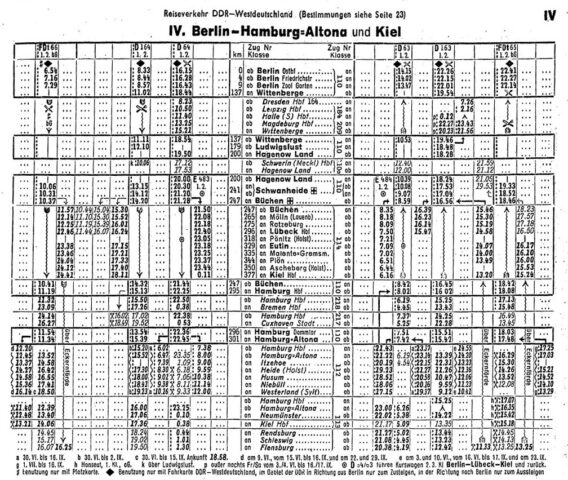
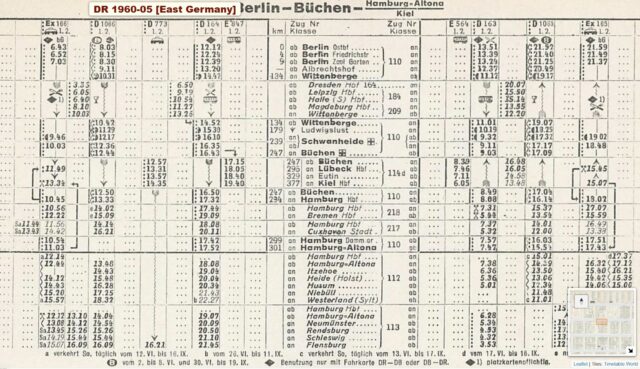
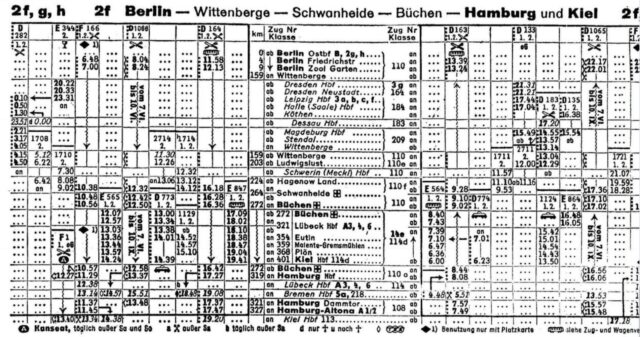
Und für den Fotografen bestand in Spandau die Herausforderung, beim Fotografieren nicht von der DDR Transportpolizei gesehen zu werden. So steht er unmittelbar am Schatten werfenden Stellwerk Spw und kann vom dortigen Personal ebenso wenig gesehen werden, wie durch die vom Zug etwa auf Höhe des letzten Wagen verdeckte Transportpolizei.
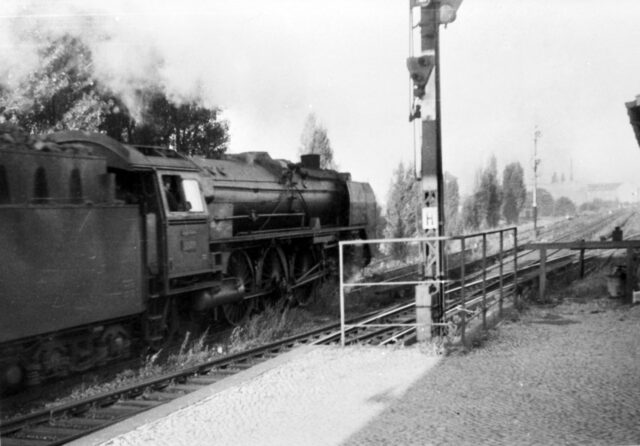
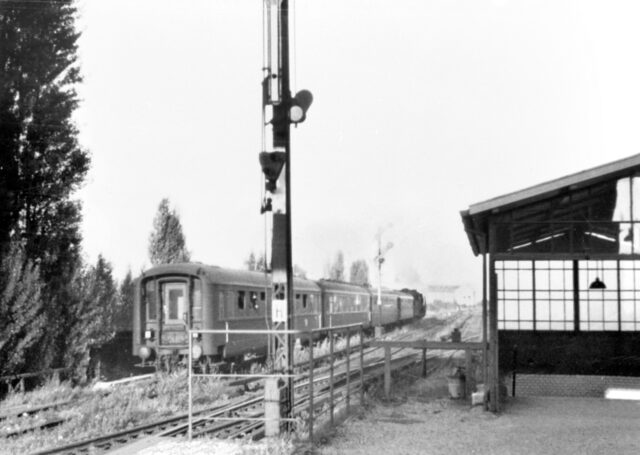
Wir wissen auch, mit welcher Geschwindigkeit der Zug den Bahnhof Spandau durcheilte, denn die Fahrschaulinie ist erhalten.

Die Lokomotive besitzt noch, wie bei der Reichsbahn üblich, die großen Wagner Bleche, allerdings die kurze Bauform und ohne Guckloch. Außerdem besitzt sie den kegelstumpfartigen Sandkastenaufsatz, der nur bei einigen Maschinen zu finden war. Trotz dieser Besonderheiten war es bis heute nicht möglich herauszufinden, welche Betriebsnummer die Maschine auf dem Foto trägt.
Der Zug setzt sich vermutlich überwiegend aus Wagen der Vorkriegsbauarten zusammen. Die beiden Schlusswagen des Zuges sind Schürzenwagen, am Ende ein B4ü-38.
Geblieben sind zwei Erinnerungsbilder des einzigen zwischen der DDR und der BRD verkehrenden FD-Zuges aus der Zeit, als die Züge von Berlin nach Hamburg noch durch Spandau fuhren.
Hans Kobschätzky
Dreieinhalb Jahrzehnte Goslar – Hommage an einen Bahnhof
Goslar - irgendwie hat mich dieser Bahnhof immer fasziniert, seit ich das erste Mal in der Jugendzeit dort war. Das war 1975 - eine Zeit, als es dort noch viele Dampflokomotiven zu sehen gab. Doch es sollte bis 2004 - also 29 Jahre - dauern, bis ich den Bahnhof wieder einmal besuchen konnte. Bei jedem Besuch entstanden Bilder von denen ich hier eine kleine Auswahl zeigen möchte.
>>> zu allen Fotos unserer Datenbank aus Goslar...
Beginnen wir an einem kalten Wintertag - es ist der 17.Januar 2010
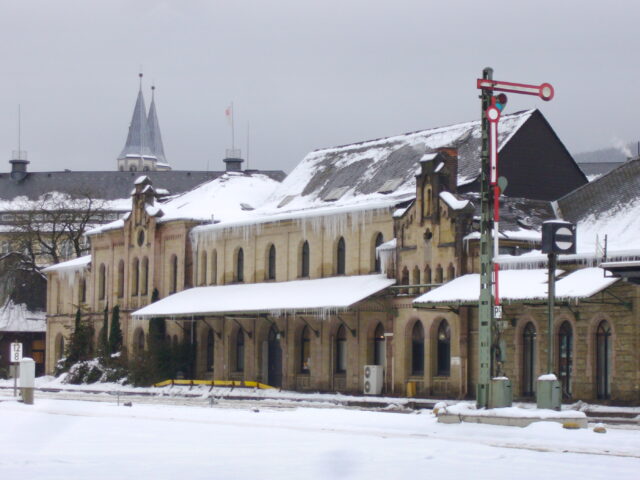
Winterlich - mit verschneiten Dächern und langen Eiszapfen - präsentiert sich das Goslarer Empfangsgebäude. Das rot-weiße Signal und eine gelbe Absperrung bringen etwas Farbe in die ansonsten grau-braune Szenerie.
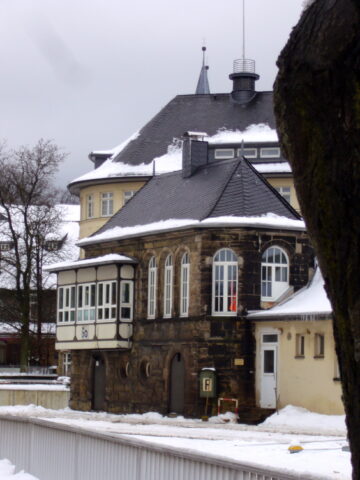
Auch das Stellwerk präsentiert sich winterlich in grau-braun. Durch das Fenster kann man Warnwesten erkennen und der Besen vor dem Fernsprechkasten zeugt vom mühevollen Winterdienst.
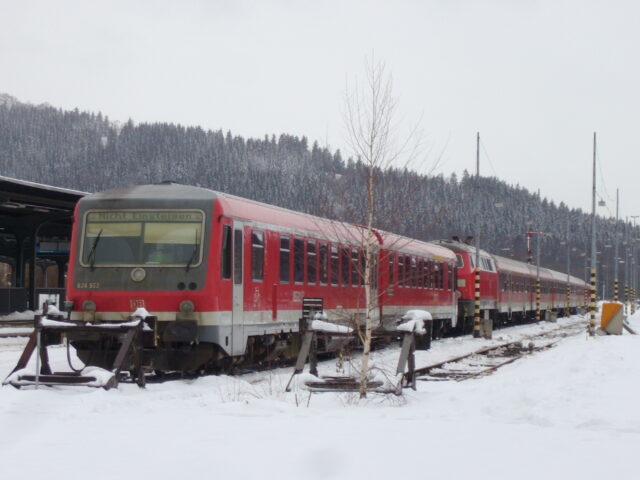
Auf den Stumpfgleisen vor der Güterabfertigung stehen der 628 552, die 218 448-9 mit einem n-Wagen Zug sowie ein weiterer 628er und warten auf den nächsten Einsatz.
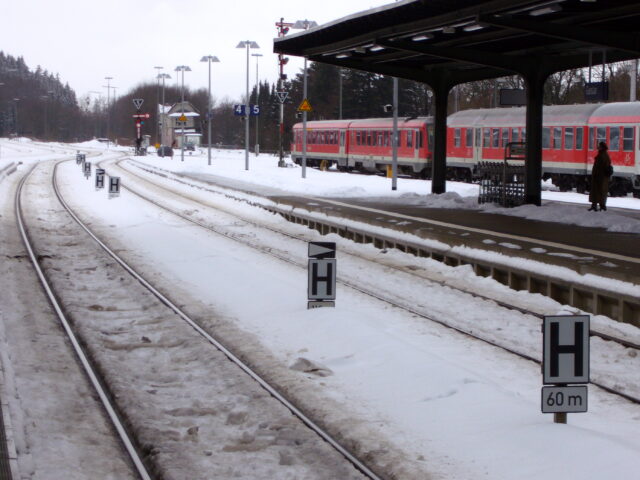
Die Ausfahrt in Richtung Kreiensen/Hildesheim ist zwischen Gleis 1 und 2 sowie Gleis 3 und 4 gesäumt von zahlreichen H-Tafeln. Im Hintergrund eines der Goslarer Zwergsignale und das Stellwerk Gwf.
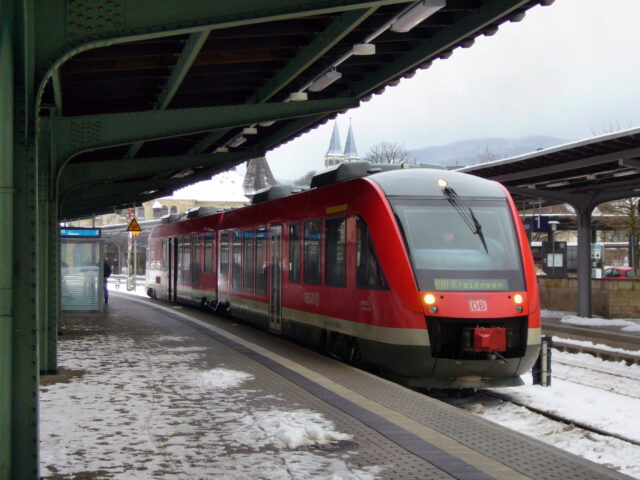
648 772 wartet als Regionalbahn nach Kreiensen auf Gleis 2. Innerhalb weniger Minuten gibt es hier Umsteigeverbindungen nach Halle, Bad Harzburg und Hannover.
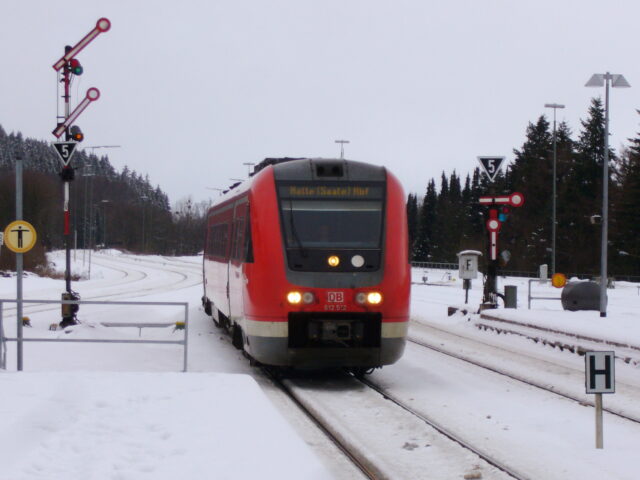
612 512 rollt als Regionalexpress nach Halle herein.
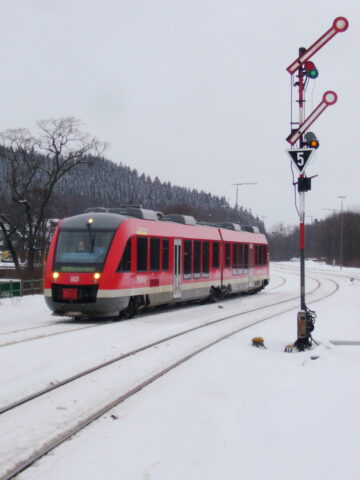
Wenig später gefolgt von einem 648er als Regionalbahn nach Bad Harzburg.
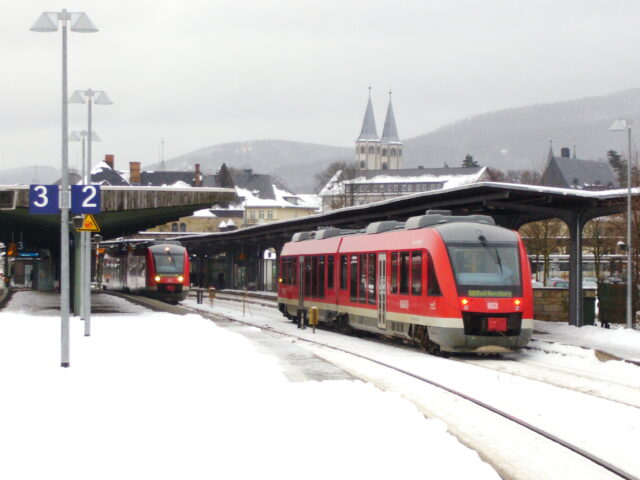
Begegnung der 648er an Gleis 1 und 2 des winterlichen Goslarer Bahnhofs.
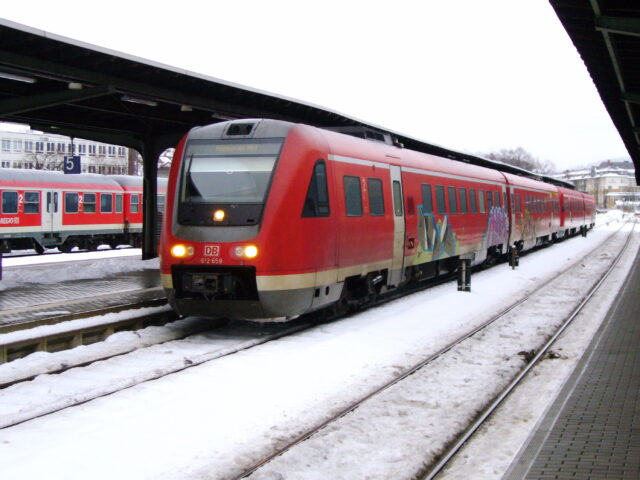
Auf Gleis 4 ist der mit Graffiti "verzierte" 612 659 als Regionalexpress nach Hannover eingelaufen.
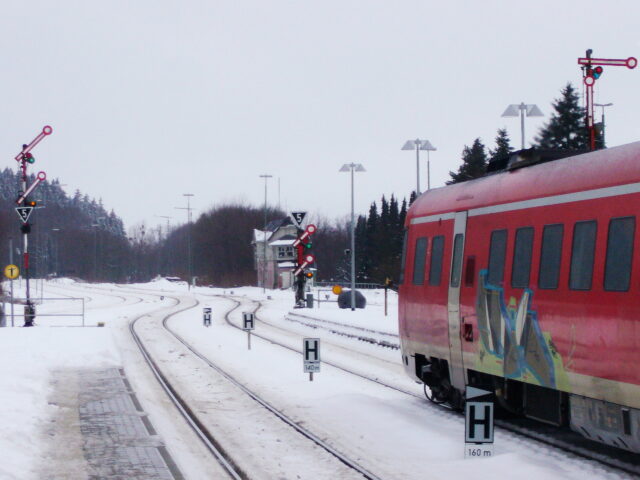
Wenig später rollt 612 659 weiter in Richtung Hildesheim.
Vier Jahre zuvor, am 02.Januar 2006 schien die Sonne. Rauhreif bedeckte die Bäume. Und der Triebwagenpark erlebte den Wandel von den 628ern zu den 648ern.
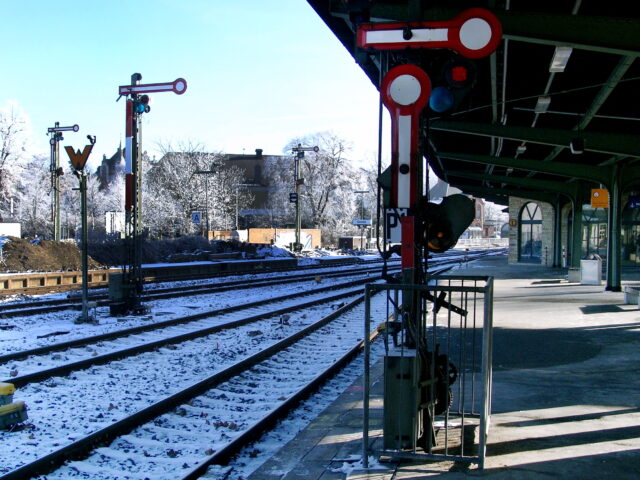
Alle Signale auf Halt - an der Goslarer Bahnhofsausfahrt in Richtung Braunschweig/Bad Harzburg.
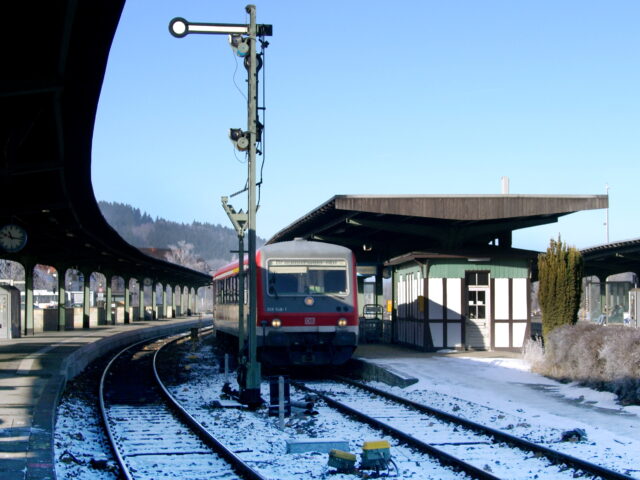
An Gleis 2 wartet 928 546-1 als Regionalbahn nach Braunschweig auf die Ausfahrt.
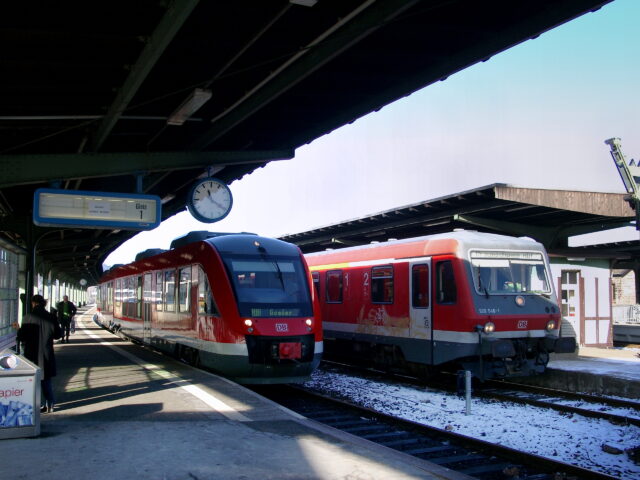
Doch zuvor gesellt sich noch der nagelneue 648 268-1 dazu.
Nach den vielen winterlichen Eindrücken ist es Zeit, in eine etwas wärmere Jahreszeit zu wechseln. Am 20.April 2005 war herrlicher Sonnenschein und viel blühende Bäume waren zu sehen, während sich zugleich erstes Grün hervorwagte.
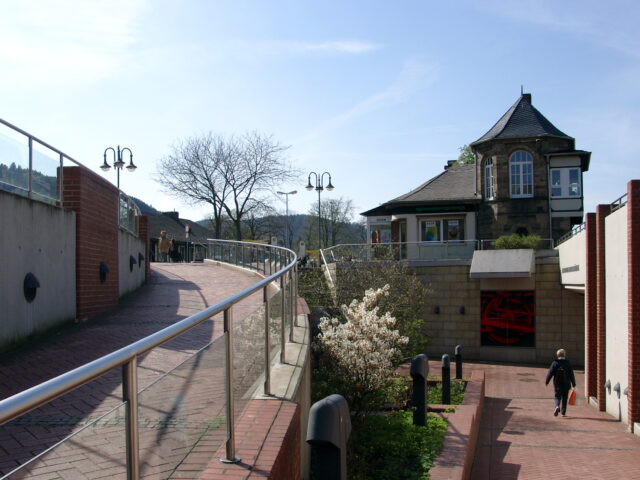
Hier, an dieser Überführung, war einst ein Bahnübergang. Ein Genuss für Eisenbahnfreunde, doch mit seinen langen Wartezeiten eine Qual für den immer dichter werdenden Autoverkehr.
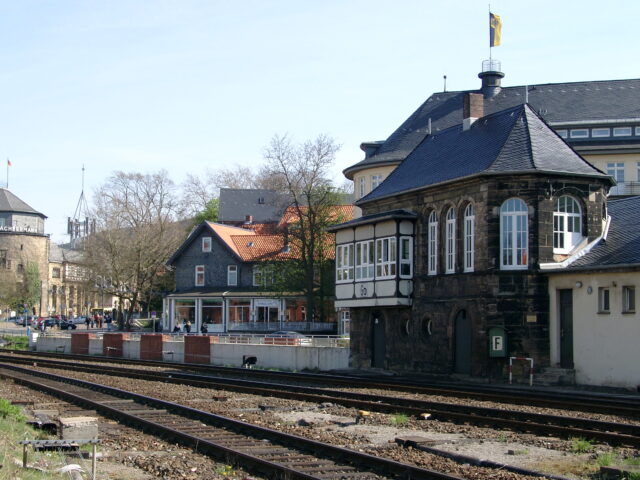
Das Stellwerk Go, welches uns bereits im Winterkleid begegnet ist, nunmehr im Frühlingssonnenschein. Am linken Bildrand das bekannte Hotel Achtermann. Und dort, wo die Beton-Backsteinwand zu sehen ist, befand sich einst der Bahnübergang.
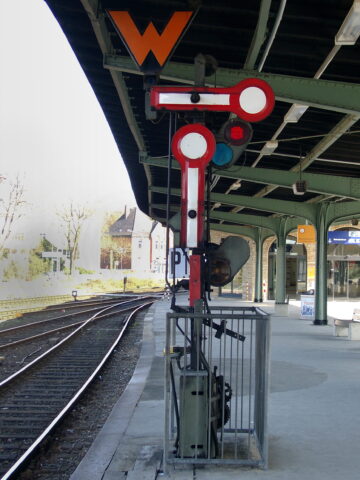
Bahnhof Goslar - die Zwergsignale gehören untrennbar dazu.
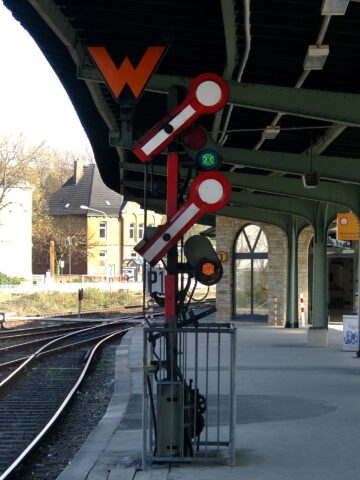
Freie Fahrt.
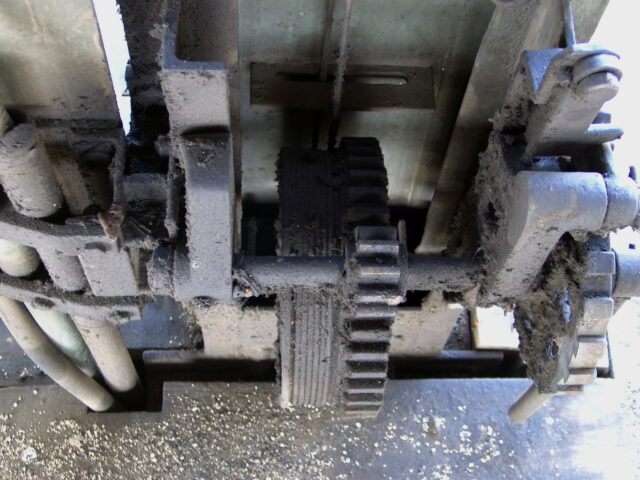
Ein Blick in die Mechanik des Zwergsignals.
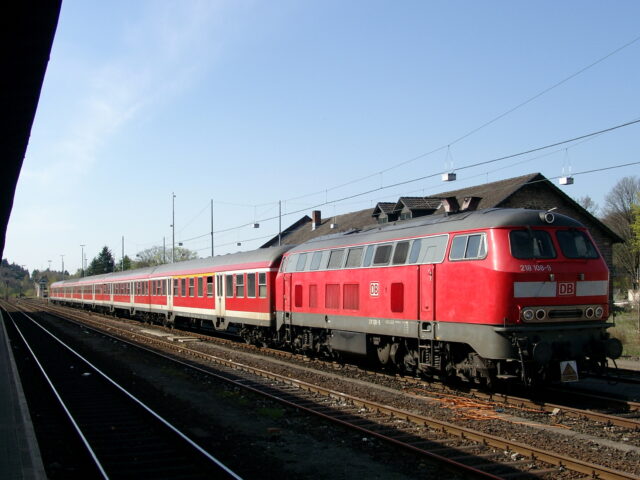
An den Stumpfgleisen an der Güterabfertigung steht wieder ein n-Wagen Zug mit einer 218, diesmal ist es die zu diesem Zeitpunkt 34 Jahre junge 218 108-9 von Krupp.
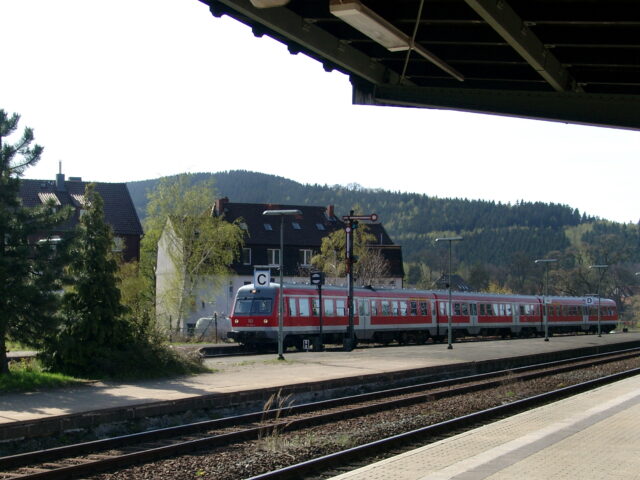
Auf Gleis 1 rollt 614 002-4/614 001-6 auf seinem Weg nach Bad Harzburg herein.
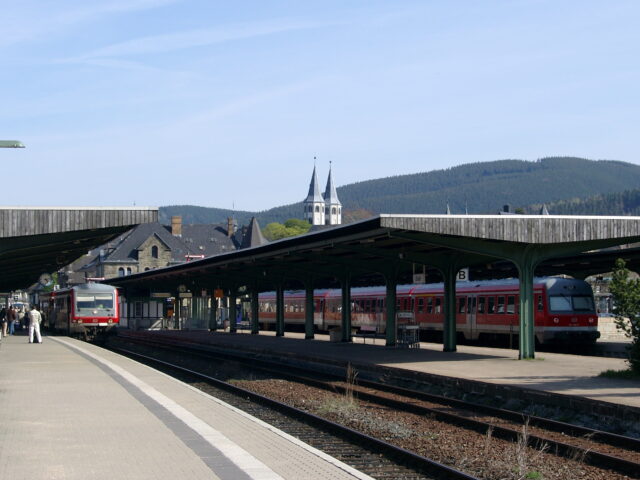
Während rechts 614 001-6/614 002-4 auf die Weiterfahrt nach Bad Harzburg wartet, steht links der als Regionalbahn aus Braunschweig hereingekommene 628 615-7.
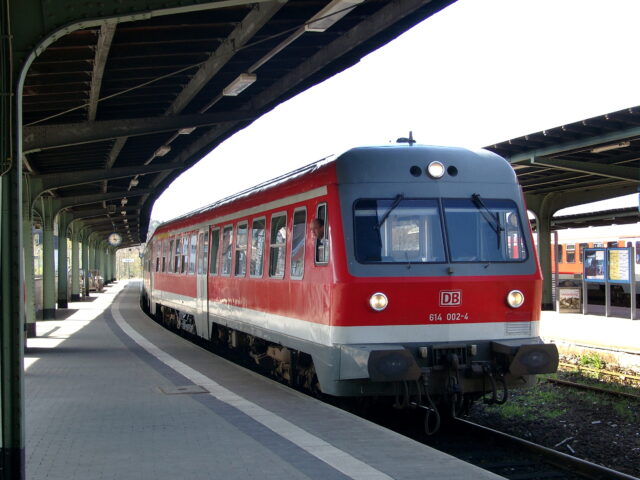
614 002-4/614 001-6 - Alle Fahrgäste sind eingestiegen und in wenigen Sekunden wird er den Bahnhof Goslar auf seinem Weg nach Bad Harzburg verlassen.
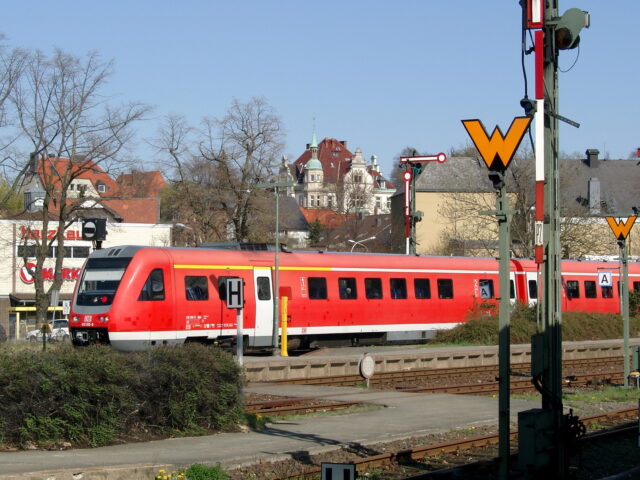
612 010-9/612 510-8 rollt herein.
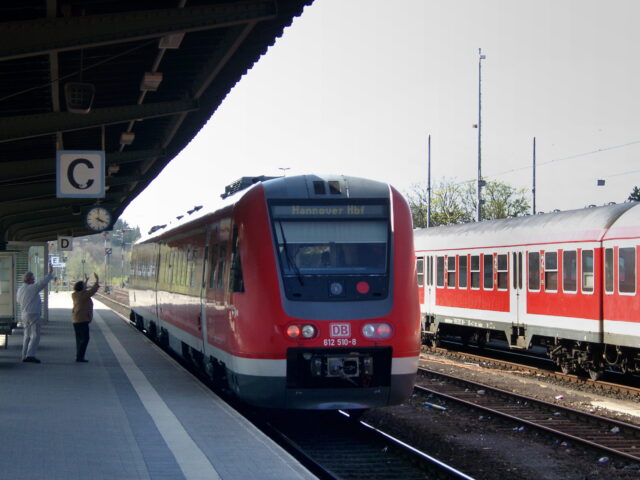
Bye bye - Auch wenn die Fahrgäste die Fenster zum Winken nicht mehr öffnen können, so kann man zumindest auf dem Bahnsteig noch winken, als 612 010-9/612 510-8 losbrummt in Richtung Hildesheim-Hannover.
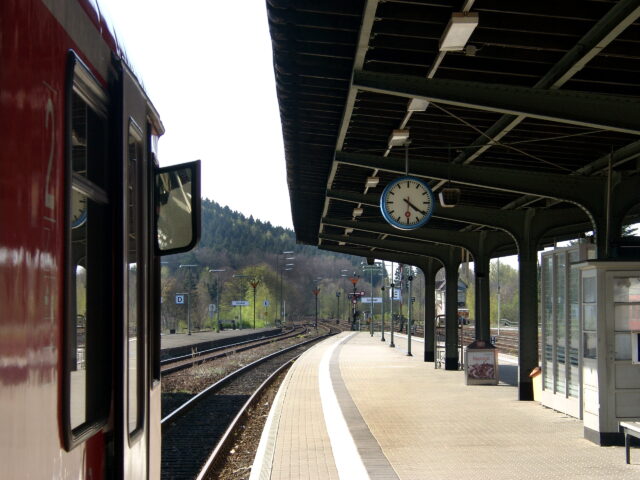
Die Zieltafel im 628 615-7 wurde weitergerollt. Statt Goslar steht nun Kreiensen im Fenster. Doch noch ist die Ausfahrt nicht freigegeben.
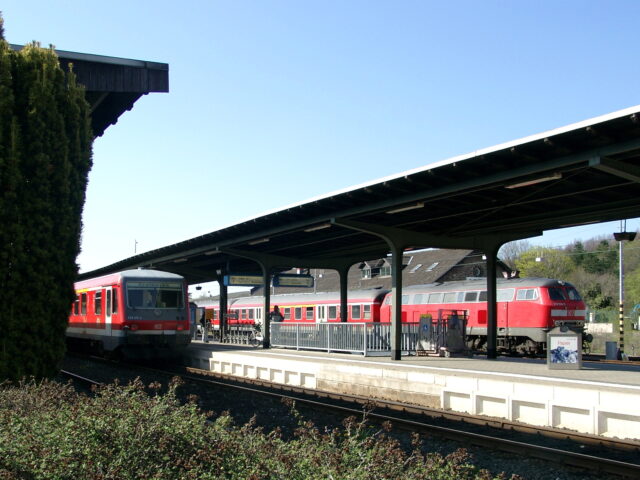
Frühlingshafte Goslarer Bahnsteigszene mit 928 615-4 und 218 108-9.
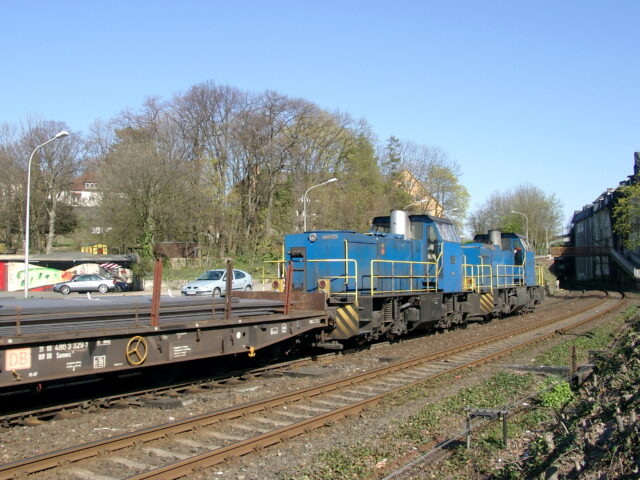
Nicht nur "rote" Züge rollen durch den Bahnhof Goslar - hier führen die Gmeinder Maschinen 1505 und xxxx der Verkehrsbetriebe Peine Salzgitter einen Zug Richtung Osten.
Der Besuch im Goslarer Bahnhof am 27.Februar 2004 zeigte noch Spuren des Winters.
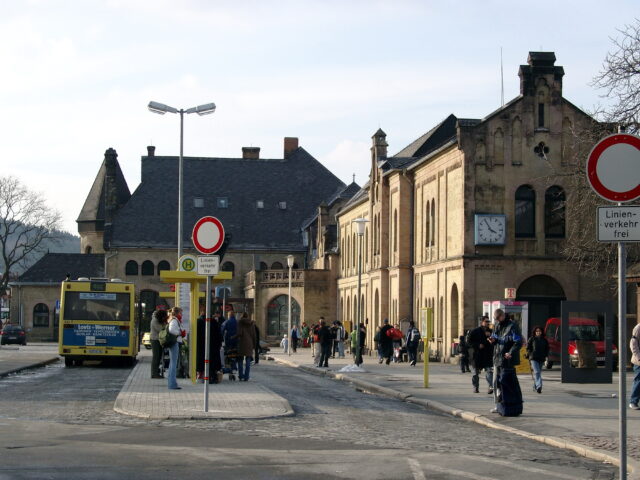
Zeigte sich die Gleisseite des Goslarer Bahnhofs zum Auftakt winterlich, so zeugen im Februar 2004 auf der Straßenseite mit den Busbahnsteigen nur noch spärliche Schneereste vom fast vergangenen Winter.
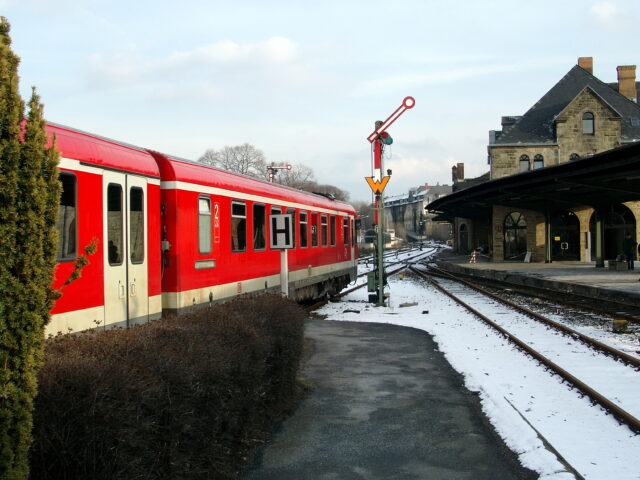
Relativ weiß sind dagegen noch die Gleise, als 628 617-3 an diesem Nachmittag den Bahnhof Goslar als Regionalbahn in Richtung Braunschweig verlässt.
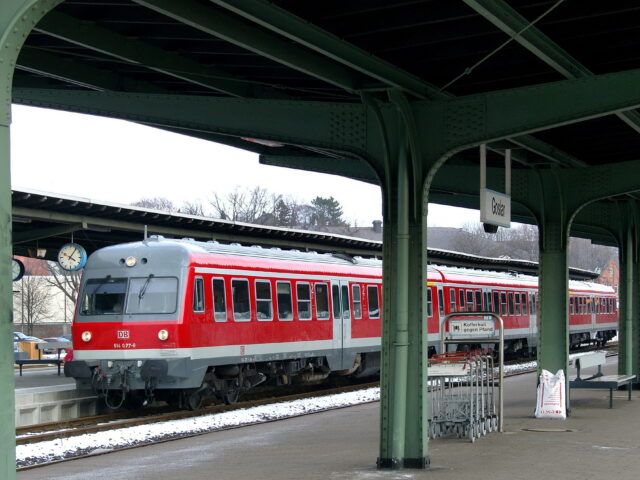
614 077-6/914 027-8/614 080-0 wartet auf Gleis 4 auf die Weiterfahrt.
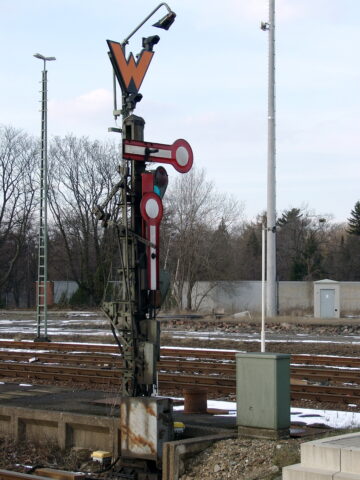
Eines der Goslarer Zwergsignale.
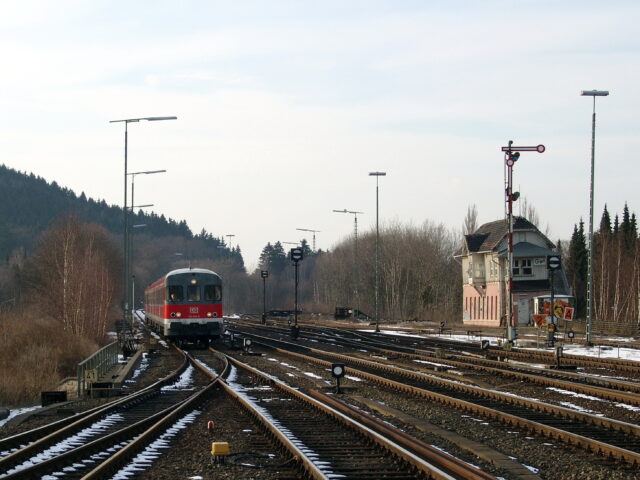
Vermutlich aus Kreiensen kommt 634 654-8/624 646-6 in den Goslarer Bahnhof herein. Die Weichenstellung verrät, dass er in Richtung Gleis 1 unterwegs ist. Rechts Stellwerk Gwf.
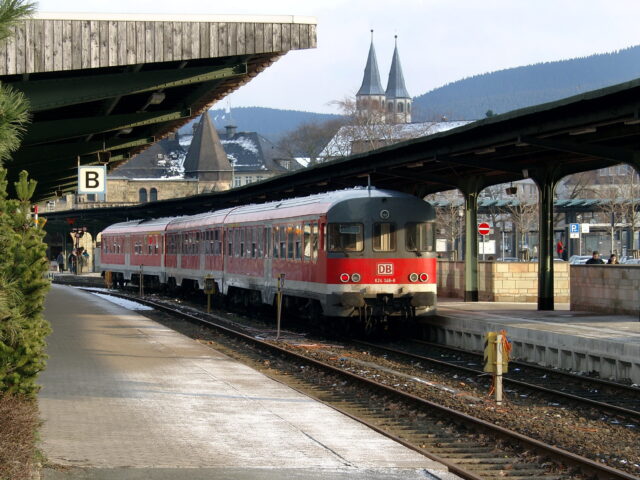
624 646-6/634 654-8 wartet an Gleis 1 auf die Weiterfahrt als Regionalbahn nach Bad Harzburg.
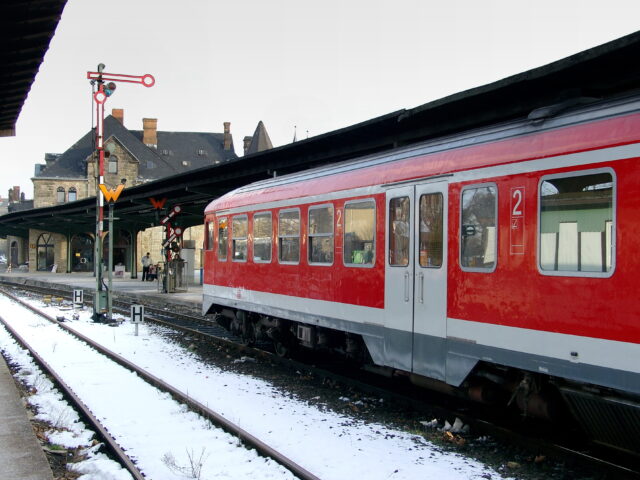
Freie Fahrt für 634 654-8/624 646-6 nach Bad Harzburg.
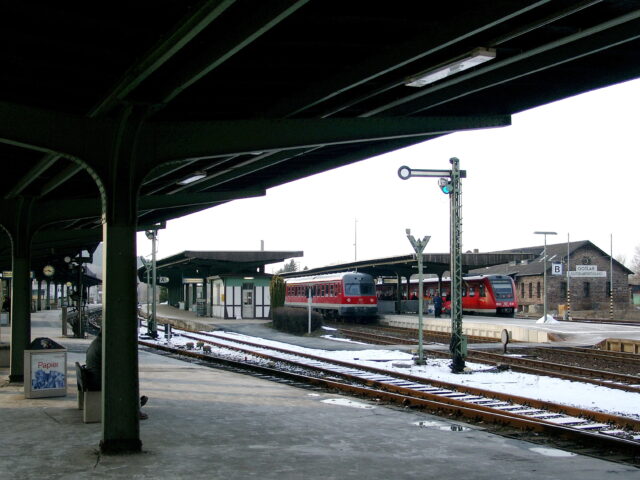
Goslarer Bahnsteigszene mit 614 080-0 und dem nach Hannover fahrenden 612 012-5.
Und nun - ein großer Zeitsprung - 29 Jahre - zum 28./29.Juli 1975. Die Bilder - noch schwarz-weiß. Mehr gab der schmale Geldbeutel eines 17jährigen nicht her. Und statt der Dieseltraktion faszinierten vor allem die Dampflokomotiven.
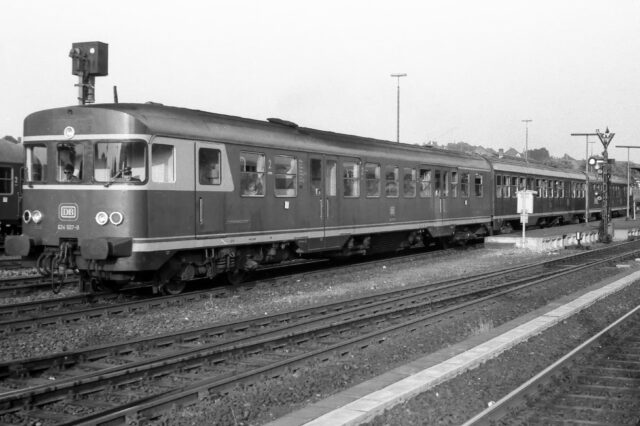
Doch zunächst eine Fahrzeuggattung, welches auch 30 Jahre später noch in Goslar anzutreffen sein sollte, der 624 507-0. Im Jahr 1961 als VT 23 503 an die DB abgeliefert, wurde er im April 2006 ausgemustert. Die Aufnahme entstand 28.07.1975.
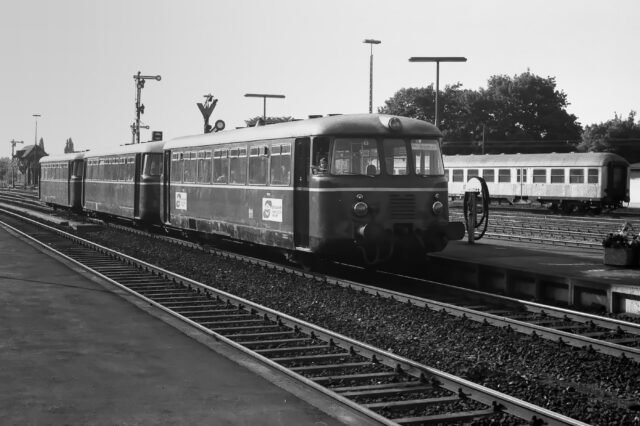
Die 1955 gebauten MAN Leichttriebwagen VT 11, VB 112 und VS 111 der Verkehrsbetriebe Horneburg (ex. Osterwieck-Wasserlebener Eisenbahn) pendelten seinerzeit zwischen Kreiensen und Goslar. Hier rollt der Zug am 29.07.1975 aus Gleis 4 in Richtung Kreiensen davon. Selbst aus dem Eckfenster des Führerstandes konnte man damals herausschauen.
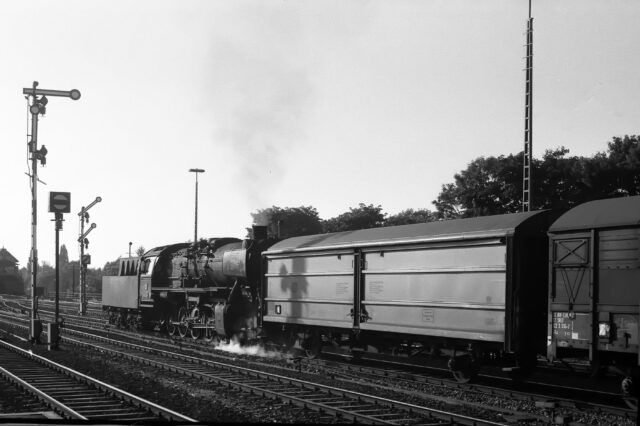
Eine unbekannte 051 bringt ihren Güterzug am 29.07.1975 in Bewegung.
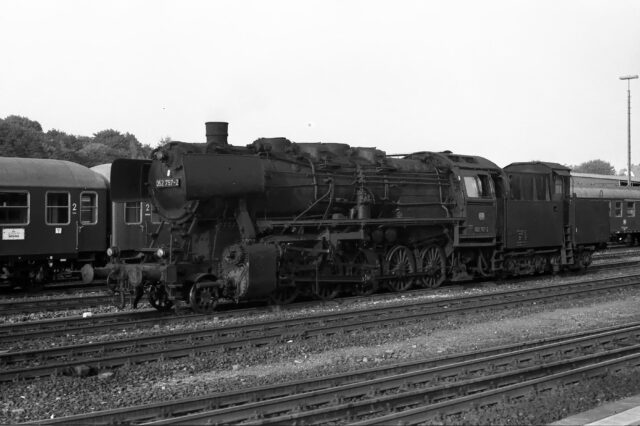
052 757-2 mit Kabinentender wartet am 28.07.1975 im Bahnhof Goslar auf den nächsten Einsatz.
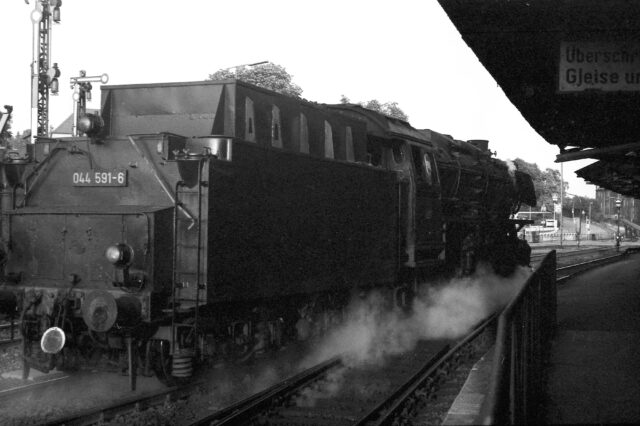
044 591-6 rollt am 28.07.1975 davon. Rechts im Hintergrund erkennt man den Bahnübergang, wo sich heute der Fußgängertunnel befindet.
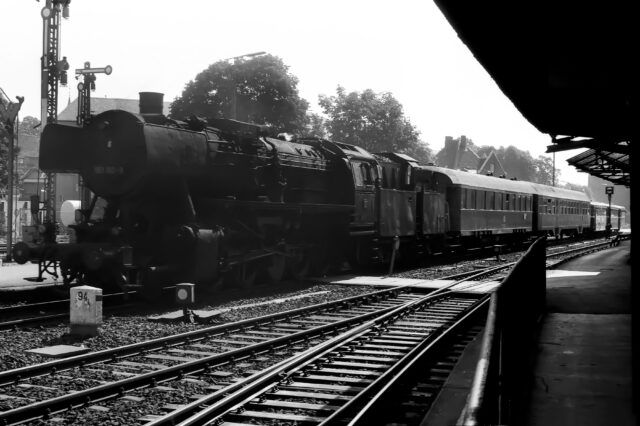
Hier rollt am 29.07.1975 eine interessante Fuhre in den Bahnhof - 051 192-3 mit Kabinentender vor dem E3536 aus Bad Harzburg. Ein Vorkriegswagen 1/2 Klasse und ein grün gestrichener Vorserien n-Wagen, das ist der ganze Zug. Hinten angehängt eine Schienenbusgarnitur, die auf der damals noch nicht stillgelegten Strecke als Nahverkehrszug nach Altenau weiterfahren wird.
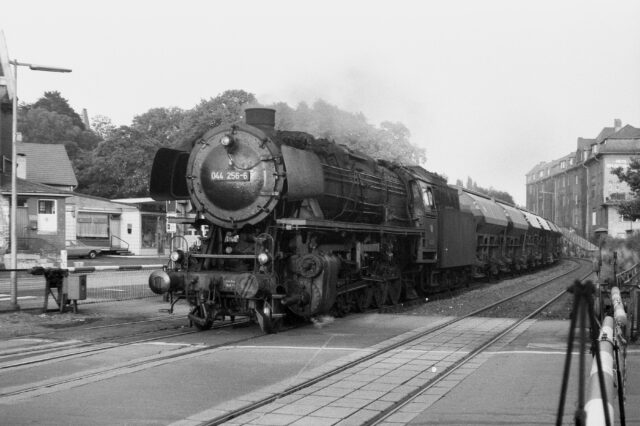
Finale - 044 256-6 mit einem Güterzug auf dem Goslarer Bahnübergang. In meinem Rücken das Stellwerk Go. Und von etwa dort, wo der Zaun rechts das Bild verlässt, entstand die Aufnahme des Zuges der Vekehrsbetriebe Peine-Salzgitter.
Damit bin ich am Ende der Bildauswahl "Dreieinhalb Jahrzehnte Goslar" angekommen. Wie der Bahnhof heute aussieht - ich weiß es nicht. Wieder sind viele Jahre seit dem letzten Besuch vergangen. Von den frühen Jahren künden historische Postkarten und Bilder. Und ich hoffe, dass ich auch in diesem Jahrzehnt vorbeischauen kann. Um zu sehen, was geblieben ist und was sich verändert hat. Doch zumindest in den Jahren, die diese Bilderserie abdeckt, war Goslar für mich immer einer der Orte, die - wie soll ich sagen - ber Jahrzehnte hinweg immer klassische Eisenbahnatmosphäre ausgestrahlt haben.
Hans Kobschätzky
